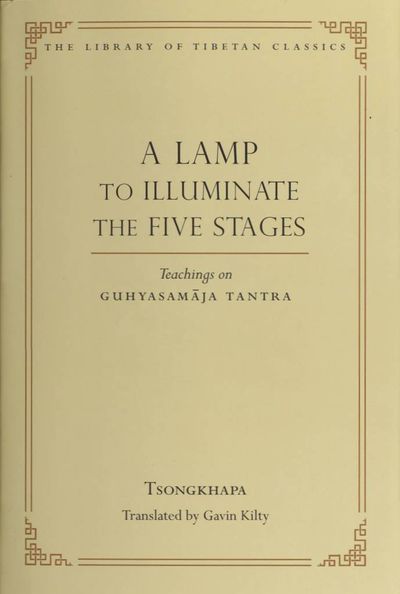A Lamp to Illuminate the Five Stages
< Books
(Created page with "{{Book |BookPerson={{Book-person |PersonPage=Kilty, G. |PersonName=Gavin Kilty }} |FullTextRead=No |AddRelatedTab=No }}") |
|||
| (8 intermediate revisions by 2 users not shown) | |||
| Line 1: | Line 1: | ||
{{Book | {{Book | ||
|BookPerson={{Book-person | |BookPerson={{Book-person | ||
| + | |PersonPage=tsong kha pa | ||
| + | |PersonName=Tsongkhapa | ||
| + | }}{{Book-person | ||
|PersonPage=Kilty, G. | |PersonPage=Kilty, G. | ||
|PersonName=Gavin Kilty | |PersonName=Gavin Kilty | ||
| + | }}{{Book-person | ||
| + | |PersonPage=Jinpa, Thupten | ||
| + | |PersonName=Thupten Jinpa | ||
}} | }} | ||
|FullTextRead=No | |FullTextRead=No | ||
| + | |BookEssay=Tsongkhapa's ''Lamp'' presents one of the most comprehensive and detailed presentations of the highest yoga class of Vajrayana Buddhism, especially the key practices— the so-called five stages (''pañcakrama'')— of the advanced phase of Guyhasamāja tantra. Beginning with a thorough examination of all the relevant Indie literature, Tsongkhapa draws particularly from the writings of Nāgārjuna, Āryadeva, Candrakīrti, and Nāropa to develop a definitive understanding of the Vajrayana completion stage. Traditionally the work belongs to a class of “hidden texts” that are to be read only by those who have received initiations. The teachings and practices in this volume follow on from those contained in the sādhana volume (volume 13). Whereas in the generation stage, meditators visualize the Buddha in the form o f the Guhyasamāja deity residing in a mandala palace, in the completion stage discussed in the present volume, meditators transcend ordinary consciousness and actualize the state of a buddha themselves. In the course of presenting these practices, Tsongkhapa's work outlines the subtle human physiology manipulated by the tantric adept, especially the network of channels and cakras, as well as the wind energies and vital drops that flow through them. Other topics, such as the Tibetan Buddhist understanding of the process of death and dying, the intermediate state of existence, and rebirth— central concepts of which find their origin in the Guhyasamāja Tantra— as well as theories of human psychology, such as the scope and dynamic of the emotions, dream states, and near-death experiences, are also addressed in detail. This text was Tsongkhapa's last major work, which he completed in 1419, the year of his death. Its impact on the course of tantric practice in Tibet has been definitive for the Geluk school and profound for Tibetan Buddhism as a whole. | ||
| + | -Thupten Jinpa, General Editor | ||
| + | |BookToc=*{{i|General Editor’s Preface|xiii}} | ||
| + | *{{i|Translator's Introduction|1}} | ||
| + | *{{i|Technical Note|17}} | ||
| + | A Lamp to Illuminate the Five Stages | ||
| + | :''Core Teachings on the Glorious Guhyasamāja, King of Tantras'' | ||
| + | *{{i|1. Homage and Introduction|21}} | ||
| + | *{{i|Part 1. Divisions of Highest Yoga Tantra}} | ||
| + | **{{i|2. The Two Types of Tantra|25}} | ||
| + | **{{i|3. Specific Explanation of Guhyasamāja Method Tantra|43}} | ||
| + | **{{i|4. Praise of Guhyasamāja|55}} | ||
| + | **{{i|5. Commentarial Traditions|59}} | ||
| + | *{{i|Part 2. The Path of Guhyasamāja}} | ||
| + | **{{i|6. Training in the Guhyasamāja|75}} | ||
| + | **{{i|7. The Two Stages|83}} | ||
| + | **{{i|8. Explanation of Evām and of Bliss and Emptiness|91}} | ||
| + | **{{i|9. The Necessity of Penetrating Vital Points on the Body |123}} | ||
| + | *{{i|Part 3. The Divisions o f the Completion Stage}} | ||
| + | **{{i|10. The Core Instruction |137}} | ||
| + | **{{i|11. TheFiveStages |143}} | ||
| + | *{{i|Part 4. Body Isolation}} | ||
| + | **{{i|12. Identifying Body Isolation |167}} | ||
| + | **{{i|13. Types of Body Isolation |181}} | ||
| + | **{{i|14. How Body Isolation Is Incorporated into the Six Yogas |191}} | ||
| + | **{{i|15. The Practice o f Body Isolation |199}} | ||
| + | *{{i|Part 5. Speech Isolation}} | ||
| + | **{{i|16. Identifying Speech Isolation |213}} | ||
| + | **{{i|17. Divisions,Functions, and Movement of the Winds |217}} | ||
| + | **{{i|18. Significance of the Mantras |253}} | ||
| + | **{{i|19. Prānāyāma Meditations |267}} | ||
| + | **{{i|20. Vajra Repetition |295}} | ||
| + | **{{i|21 . Experiences in Prānāyāma Meditation |309}} | ||
| + | *{{i|Part 6. Mind Isolation}} | ||
| + | **{{i|22 . The Nature of Mind Isolation |333}} | ||
| + | **{{i|23. The Three Appearances and the Intrinsic Natures |341}} | ||
| + | *{{i|Part 7. The Conventional-Truth Illusory Body}} | ||
| + | **{{i|24. Gaining Instructions on the Illusory Body}} | ||
| + | **{{i|25. Methods of Attaining the Illusory Body}} | ||
| + | **{{i|26. The Mixings}} | ||
| + | *{{i|Part 8. The Ultimate-Truth Clear Light}} | ||
| + | **{{i|27. Stages of Attainment|443}} | ||
| + | **{{i|28. The Outer and Inner Mastery |447}} | ||
| + | **{{i|29. The Two Meditative Absorptions |453}} | ||
| + | **{{i|30. How the Path of Tantra Must Occur on the Sutra Path |463}} | ||
| + | **{{i|31. How Clear Light Is Incorporated into the Six Yogas |475}} | ||
| + | *{{i|Part 9.The Stage of Union}} | ||
| + | **{{i|31 . The Two Truths Inseparably Combined |483}} | ||
| + | **{{i|33. How the Stage of Union Fits into the Six Yogas |503}} | ||
| + | *{{i|Part 10. Tantric Activities}} | ||
| + | **{{i|34. General Presentation of Activities |509}} | ||
| + | **{{i|35. HighestYoga Tantra Activities|527}} | ||
| + | **{{i|36. Rituals for the Three Activities|541}} | ||
| + | **{{i|37. The Attainment of Complete Enlightenment|559}} | ||
| + | *{{i|Colophon and Dedication|563}} | ||
| + | *{{i|Table of Tibetan Transliteration|567}} | ||
| + | *{{i|Notes|569}} | ||
| + | *{{i|Glossary|605}} | ||
| + | *{{i|Bibliography|617}} | ||
| + | *{{i|Index|629}} | ||
| + | *{{i|About the Contributors|649}} | ||
| + | |StopPersonRedirects=No | ||
|AddRelatedTab=No | |AddRelatedTab=No | ||
}} | }} | ||
Latest revision as of 15:58, 10 August 2023
Tsongkhapa’s A Lamp to Illuminate the Five Stages (1419) is a comprehensive presentation of the highest yoga class of Buddhist tantra, especially the key practices—the so-called five stages (pancakrama)—of the advanced phase of Guhyasamāja tantra. Beginning with a thorough examination of the Indian sources, Tsongkhapa draws particularly from the writings of Nāgārjuna, Aryadeva, Candrakīrti, and Nāropā to develop a definitive understanding of the Vajrayana completion stage. Whereas in the generation stage, meditators visualize the Buddha in the form of the deity residing in a mandala palace, in the completion stage discussed in the present volume, meditators transcend ordinary consciousness and actualize the state of a buddha themselves. Among other things, Tsongkhapa’s work covers the subtle human physiology of channels and winds along with the process of dying, the bardo, and rebirth. This definitive statement on Guhyasamāja tantra profoundly affected the course of Buddhist practice in Tibet. (Source: Wisdom Experience)
| Citation | Kilty, Gavin, trans. A Lamp to Illuminate the Five Stages: Teachings on Guhyasamāja Tantra. By Tsongkhapa (tsong kha pa). Edited by Thupten Jinpa. Library of Tibetan Classics 15. Boston: Wisdom Publications, 2013. |
|---|---|


